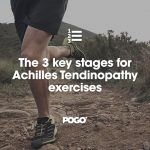The role of the brain in tendon pain

Interestingly and refreshingly for many chronic tendon pain sufferers, researchers have revealed that the brain can actually play a significant role in the experience of tendon pain.
In chronic tendon pain cases, the tendon itself may no longer be ‘damaged’ per se, yet pain originating from the tendon can still remain. How can this be possible?
It can be quite a complex algorithm, but in short the brain perceives pain as a result of the nervous system’s threshold has been reduced or lowered. The lowering of the pain threshold in essence means that a given stimuli even if not threatening, can actually be perceived by the body’s nervous system as threatening, thereby eliciting a pain response that otherwise would not have occurred.
The brain perceives pain as a result of the nervous system’s threshold has been reduced or lowered. #performbetter @pogophysio Share on XIn essence the brain ‘asks’ How dangerous is this really? in response to threatening stimuli such as an injury incurred by the body.
The brain’s ‘response’ to this ‘question’ is based on many factors that when combined allow the brain to generate a response and output signals in terms of degree of pain felt, movements of the body, immune and hormonal responses, and fight or flight responses on occasions.
The factors that determine the brain’s response include:
- Sensory input from the body
- Previous experience
- Cultural factors
- Social/work environment
- Expectations about consequences (of danger and of pain)
- Beliefs, knowledge, and logic
The brain’s response is to derive the ‘meaning’ of the above, which will in turn determine the person’s expectation and anxiety levels of the threatening stimuli.
The brain’s response is to derive the ‘meaning’, which will determine the person’s expectation. #performbetter @pogophysio Share on XWhen the threat is disproportionately perceived and the body’s output is therefore excessive, the person can experience pain that otherwise would not be detected.
When this occurs clinicians and researchers alike refer to this pain state as ‘centralised’ or ‘neuropathic’ tendon pain.
A classic hallmark of this pain is that sufferers can report that the pain ‘shifts and spreads’ in the pain location. Unlike reactive tendon pain of the Achilles where sufferers can typically point to the sore part of the tendon and put one finger on the pain, centralised pain of the Achilles tendon would be more diffuse in location, widespread and changing in its location and description. Such tendon pain typically cannot be precisely pointed to.
In instances of such centralised tendon pain, treatment strategies are based on cortical re-organization of the brain, to enhance the body’s threshold of pain. For an example of how powerful cortical re-organisation can be watch the video below.
Clinically the physiotherapist treating a client with centralised tendon pain needs to educate the person (1) that:
- Pain does not necessarily equal harm
- The part of the tendon that is actually pathological, is normally very small relative to the part of the tendon that is healthy
- Pain experienced through rehabilitation is normal
- Pain has become a threshold issue not a structural tendon issue (‘your threshold to your nervous system is lower’)
- Timelines to rehabilitate such centralised tendon pain are typically long (e.g. 12-18months)
Astute treatment and communication focusses on minimising the threat of the pathology. It also needs to focus on developing an understanding of what the injured runner believes regarding the cause of their injury, and also their expectations around their recovery.
Malliaris recommends that several key questions get asked when rehabilitating tendon pathologies. These questions are pertinent to get answers to for sufferers of centralised tendon conditions, and can be selectively asked for runner’s who have more typical reactive or degenerative tendon conditions.
The questions to ask include:
- What have you been told about your condition?
- What is your understanding about your injury and why it has occurred?
- Do you feel that you need to avoid pain or stop when you feel pain?
- Do you feel that you are causing damage when you feel pain?
- Do you really think this will get better?
- Does part of you think that this will not get better?
- Why is it important to you that this gets better?
- What will you do differently if you were better?
- Do you understand what you need to do?
If you are struggling with a tendon injury feel free to leave your question below.
To read more around tendons:
7 things to avoid with a painful tendon
Tendonitis or Tendinopathy? Classifying Tendon Pain
My preferred tendon clinical classification system
Physio With A Finish Line,

Brad Beer (APAM)
Physiotherapist (APAM)
Author ‘You CAN Run Pain Free!’ Amazon Running & Jogging Bestseller
Founder POGO Physio
References
(1) Malliaris, P (2016). Matering the Lower Limb Tendinopathy workshop (Sep 2016, Brisbane Australia).
Featured in the Top 50 Physical Therapy Blog









it’s crazy when we can’t find an answer to our question: how does the brain affect the tendons? nothing in the medical pages like the thousands of questions asked about hidden brain problems. that’s why neurologists are arrogant, they don’t give us the opportunity to ask a question, since they don’t have answers.